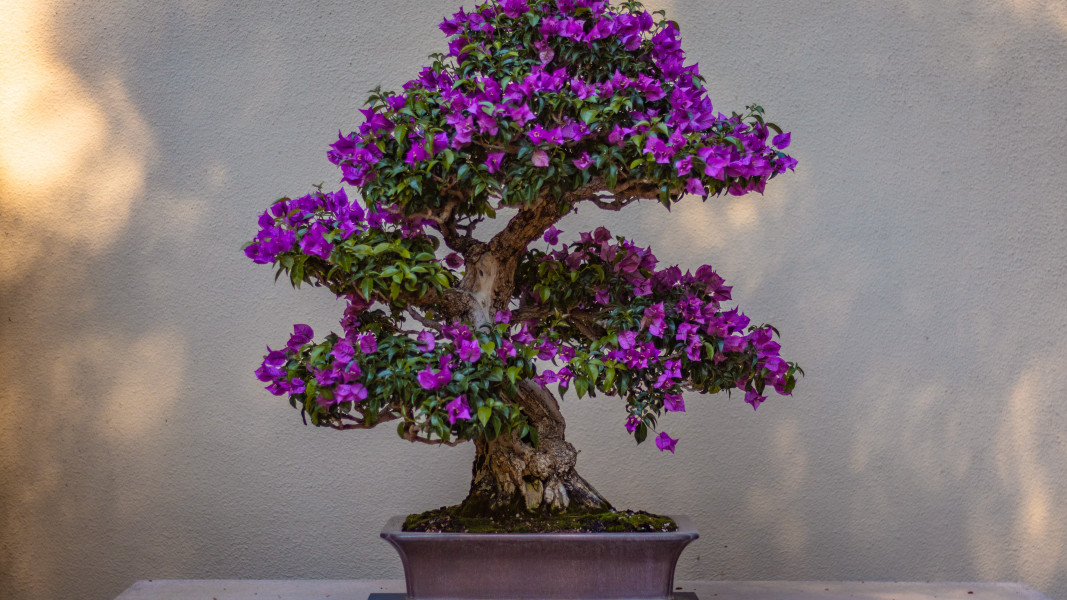Bonsai is the art of growing a miniature tree that is an exact copy of the original. The secret of its small size is in the flattened root system. It allows you to control the growth of the plant at all stages of development. This feature is reflected in the name, "bonsai" translates from Chinese as "grown in a tray".
The art originates from China. According to legend, the ruler ordered the recreation of the natural landscape and architecture of the empire in miniature. That's how bonsai was born.
During the 6th century the technique of mini-wood came to Japan. Local craftsmen have perfected the process. Over time, bonsai has not lost its popularity: new styles and trends are emerging. The secrets of the craft have become available to the public so that anyone can grow bonsai.
What Exactly is Bonsai?
Bonsai is a miniature plant that consists of a small reproduction of a tree that we find in nature in its canonical dimensions. Therefore, the bonsai is not a genetic dwarf plant, but a normal tree, which through skilled gardening techniques acquires reduced features. Any tree can be transformed into a bonsai, but it takes a lot of patience, perseverance, dedication, passion, technical skills and a pinch of creativity. Growing bonsai, more than just a hobby, can be considered a true work of art in constant evolution, forged by time, shaped by technology and modeled by human inspiration.
It also has therapeutic value, as this technique is able to relax the nervous system and soothe anxiety. The bonsai should be as faithful as possible to the original tree, respecting its characteristics and reproducing the harmony of shapes and balance of proportions.
In ancient times in China it was believed that the cultivation of bonsai for a long time could guarantee the eternity of the soul of its owner, almost as if this technique is a bridge between heaven and earth, between the sacred and the human.
Brief History of Bonsai
Contrary to popular belief, the home of bonsai is actually China, not Japan. It was only later that these saplings and related techniques were established in Japan, and from there, more recently, they also spread to the West.
Among the various legends about the origin of bonsai, the most common is the one that traces its spread to the need to exploit plants for herbal and medicinal purposes. Entering the forest every time in search of the most suitable tree soon turns out to be an expensive and difficult undertaking.
Therefore, the idea is born to keep trees in the house or garden. It was understood that by proper pruning the size of the plants can be limited by creating miniature saplings, true reproductions of the original specimens. The resulting bonsai turned out to be so pleasant that it was decided to use them for decorative purposes.
From China, around the 13th century, bonsai art reached Japan. It was brought there by monks, merchants, court dignitaries. Originally, this was an elite technique reserved for the ruling classes. Gradually, bonsai cultivation also gradually spread to the lower classes.
Over time, the technique improved, in an attempt to recreate figures more and more similar to the original. There has been an evolution in the choice of vases, favoring the sobriety of shapes and colors. In 1935, bonsai was recognized as a true "art" in Japan.
The Japanese origin is also the origin of the term: the word bonsai actually comes from the union of two ideograms and literally means "tree in a tray".
In Europe, the bonsai was presented at the Universal Exposition in Paris (in the editions of 1878, 1889 and 1900) and almost simultaneously presented at the London Exposition in 1909.
The first bonsai were sold at auction for exorbitant prices during this period, but they did not achieve much public success. In Europe, the large-scale diffusion of bonsai did not occur until after World War II.
Bonsai, When and How to Water?
In addition to light, another essential element for plants is water. Also in this case, the speech given in the previous paragraph is valid: a lot depends on the species to which our tree belongs. In general, however, bonsai need constant irrigation, but like all plants suffer from water stagnation.
An infallible method to find out if there is a need for watering is to test the soil: if it is wet, then it will be necessary to postpone, if the soil is dry, it will be necessary to water. The best method of watering is by sprinkler irrigation.
Sometimes it is recommended to completely immerse the roots of bonsai in a container filled with water for a few minutes.
In fact, this operation should be performed only in the presence of very clay soil, with poor drainage power. Immersion is not recommended for young plants, as it can cause root rot and in general, because it prevents the elimination of toxins and salt residues from the soil.
In summer or in any case during periods of drought, it is advisable to spray the leaves of our bonsai with a sprayer that keeps the leaves constantly moist.
How to Choose a Bonsai Tree?
Anyone who decides to take up this ancient and fascinating art must first choose the bonsai he/she intends to grow.
As mentioned, virtually all pants can be miniaturized in a bonsai version.You need to decide whether to go bonsai indoors or outdoors.
If we choose one outdoors, our choice should preferably be directed to those species that live and thrive around our home or in our area. We will have to take into account, above all, the ecological and climatic characteristics of the area in which we live. In this way you will avoid problems with the rooting of plants, while also guaranteeing a better result from a scenographic point of view.
On the other hand, indoor bonsai is less demanding than the ecological level.
Among beginners, one of the most widely grown types of bonsai is the ficus, relatively easy to care for and form an indoor plant. Other plants especially suitable for beginners are Chinese elm and black pine.

